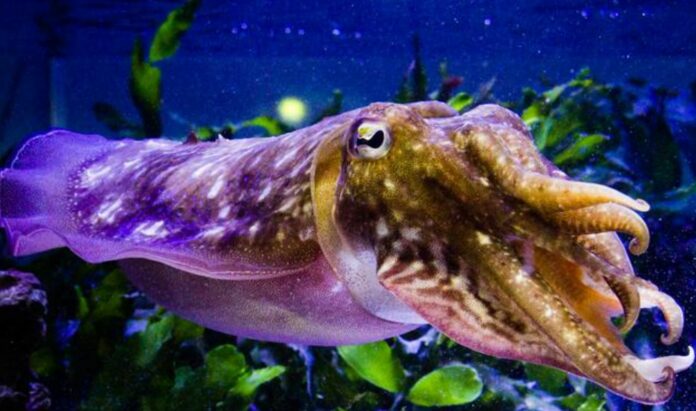New Research Unveils how cuttlefish utilize millions of skin cells and sophisticated neural controls to adapt their camouflage in response to changing surroundings.
Cuttlefish, alongside other cephalopods like octopus and squid, possess remarkable camouflage abilities, allowing them to change their skin color and texture to blend seamlessly with their underwater surroundings.
In a study published today in Nature, researchers from the Okinawa Institute of Science and Technology (OIST) and the Max Planck Institute for Brain Research have revealed that the process by which cuttlefish generate their camouflage patterns is far more intricate than previously thought.
Cuttlefish achieve their captivating skin patterns by precisely controlling millions of tiny skin pigment cells known as chromatophores. Each chromatophore is encircled by a set of muscles that contract and relax under the direct command of neurons in the brain. When the muscles contract, the pigment cell expands, and when they relax, the pigment cell becomes concealed. Together, these chromatophores function as cellular pixels, creating the overall skin pattern.
Professor Sam Reiter, leader of the Computational Neuroethology Unit at OIST, explained, “Prior research suggested that cuttlefish only had a limited selection of pattern components that they would use to achieve the best match against the environment. But our latest research has shown that their camouflaging response is much more complicated and flexible – we just hadn’t been able to detect it as previous approaches were not as detailed or quantitative.”
To make this discovery, the team employed an array of ultra-high-resolution cameras to zoom in on the skin of the common European cuttlefish, Sepia officinalis. They presented the cuttlefish with various backgrounds and captured the real-time expansion and contraction of tens to hundreds of thousands of chromatophores as the cuttlefish transitioned between camouflage patterns.
The researchers processed approximately 200,000 skin pattern images using the supercomputer at OIST and analyzed them using a neural network, a form of artificial intelligence. The neural network holistically examined different elements of the skin pattern images, such as roughness, brightness, structure, shape, contrast, and more complex image features. Each pattern was then assigned a specific location in “skin pattern space,” a term coined by scientists to describe the complete spectrum of skin patterns generated by the cuttlefish.
The team employed the same process to analyze images of the background environment and assessed how well the skin patterns matched the surroundings.
The researchers discovered that cuttlefish have the ability to exhibit a diverse range of skin patterns and can adeptly and flexibly adjust their patterns to match both natural and artificial backgrounds. Interestingly, when the same background was presented multiple times to the cuttlefish, the resulting skin patterns subtly differed in ways imperceptible to the human eye.
The paths that the cuttlefish followed to achieve each skin pattern were indirect. They transitioned through various skin patterns, pausing in between, with each pattern change refining the camouflage until they settled on a pattern that seemed satisfactory. Remarkably, even when faced with the same two backgrounds, the paths taken by the cuttlefish were never identical, highlighting the complexity of their behavior.
“The cuttlefish would often overshoot their target skin pattern, pause, and then come back,” noted Theodosia Woo, joint first author of the study and graduate student in the Max Planck Institute for Brain Research team. “In other words, cuttlefish don’t simply detect the background and go straight to a set pattern, instead, it is likely that they continuously receive feedback about their skin pattern and use it to adjust their camouflage. Exactly how they receive that feedback – whether they use their eyes, or whether they have a sense of how contracted the muscles around each chromatophore are – we don’t yet know.”
The researchers also examined another skin pattern display known as blanching, which occurs when cuttlefish rapidly pale in response to a threat.
“Unlike camouflaging, blanching was fast and direct, suggesting it uses a different and repeatable control system,” explained Dr. Dominic Evans, a postdoctoral fellow in the Max Planck Institute for Brain Research team.
Upon capturing high-resolution images of the blanching display, the researchers noticed that certain elements of the previous camouflage pattern persisted, with the blanching pattern overlaying them. Subsequently, the cuttlefish gradually and reliably returned to displaying their pre-blanching skin pattern.
“This suggests that information about the initial camouflage somehow remains. The blanching is more like a response that temporarily overrides the camouflage signals from the brain and might be controlled by a completely different neural circuit in the brain,” elaborated Dr. Xitong Liang, joint first author of the study and former postdoctoral researcher in the Max Planck Institute for Brain Research team.
“The next step is to capture neural recordings from cuttlefish brains, so we can further understand exactly how they control their unique and fascinating skin patterning abilities.”
Source: 10.1038/s41586-023-06259-2
Image Credit: Stephan Junek, MPI Brain Research
